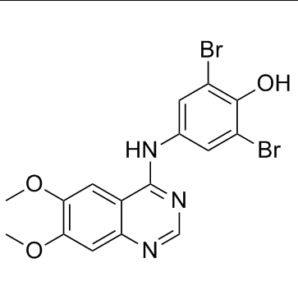WHI-P97
This product is for research use only, not for human use. We do not sell to patients.

For small sizes, please check our retail website as below: www.invivochem.com
| Size | Price | Stock |
|---|---|---|
| 250mg | $1150 | Check With Us |
| 500mg | $1750 | Check With Us |
| 1g | $2625 | Check With Us |
Cat #: V3972 CAS #: 211555-05-4 Purity ≥ 98%
Description: WHI-P97 is a novel, rationally designed, and potent inhibitor of Janus kinase (JAK)-3 with an estimated Ki value of 0.09 μM in modeling studies and a measured IC50 value of 2.5 μM in EGFR kinase inhibition assays.
Top Publications Citing Invivochem Products
Publications Citing InvivoChem Products
Product Promise

- Physicochemical and Storage Information
- Protocol
- Related Biological Data
- Stock Solution Preparation
- Quality Control Documentation
| Molecular Weight (MW) | 455.11 |
|---|---|
| Molecular Formula | C16H13Br2N3O3 |
| CAS No. | 211555-05-4 |
| Storage | -20℃ for 3 years in powder formr |
| -80℃ for 2 years in solvent | |
| Solubility In Vitro | DMSO: 10 mg/mLr |
| Water: <1 mg/mLr | |
| Ethanol:<1 mg/mL | |
| SMILES Code | OC1=C(Br)C=C(NC2=C3C=C(OC)C(OC)=CC3=NC=N2)C=C1Br |
| Synonyms | WHIP 97; WHIP97; WHIP-97; WHI-P97; WHI-P 97; WHI-P 97 |
| Protocol | In Vitro | WHI-P97 (30 μM) stantially reduces the IgE/antigen-induced LTC4 release from mast cells. WHI-P97 inhibits the translocation of 5-lipoxygenase (5-LO) from the nucleoplasm to the nuclear membrane and consequently 5-LO-dependent leukotriene (LT) synthesis after IgE receptor/FcεRI crosslinking by >90% at low micromolar concentrations. |
|---|---|---|
| In Vivo | WHI-P97 (intraperitoneal injection; 40 mg/kg; 24 days) prevents ovalbumin-sensitized mice the development of airway hyper-responsiveness to methacholine in a dose-dependent fashion in mice. WHI-P97 inhibits the eosinophil recruitment to the airway lumen after the ovalbumin challenge in a dose-dependent fashion. WHI-P97 (i.v. injection; 40 mg/kg; single dose) has an elimination half-life (t1/2) of 58.9 min and systemic clearance (CL) of 891 ml/h/kg in CD-1 mice and a t1/2 of 84.2 min and CL of 1513 ml/h/kg in BALB/c mice. The values for AUC and Cmax are 107.3 μM and 296.7 μM, respectively, in CD-1 mice. And the IC50 values are 58.4 μM and 212.7 μM, respectively, in BALB/c mice. The large volume of distribution are 322 ml/kg in CD-1 mice and 415 ml/kg in BALB/c mice. WHI-P97 is very well tolerated in mice, with no signs of toxicity at dose levels ranging from 5 μg/kg to 50 mg/kg, and LD10 is not reached at a 50 mg/kg dose level when administered as a single i.p. or i.v. bolus dose. |
These protocols are for reference only. InvivoChem does not
independently validate these methods.
| Solvent volume to be added | Mass (the weight of a compound) | |||
|---|---|---|---|---|
| Mother liquor concentration | 1mg | 5mg | 10mg | 20mg |
| 1mM | 2.1973 mL | 10.9864 mL | 21.9727 mL | 43.9454 mL |
| 5mM | 0.4395 mL | 2.1973 mL | 4.3945 mL | 8.7891 mL |
| 10mM | 0.2197 mL | 1.0986 mL | 2.1973 mL | 4.3945 mL |
| 20mM | 0.1099 mL | 0.5493 mL | 1.0986 mL | 2.1973 mL |
The molarity calculator equation
Mass(g) = Concentration(mol/L) × Volume(L) × Molecular Weight(g/mol)
Mass
=
Concentration
×
Volume
×
Molecular Weight*
The dilution calculator equation
Concentration(start)
×
Volume(start)
=
Concentration(final)
×
Volume(final)
This equation is commonly abbreviated as: C1 V1 = C2 V2
Concentration(start)
C1
×
Volume(start)
V1
=
Concentration(final)
C2
×
Volume(final)
V2
Step One: Enter information below
Dosage mg/kg
Average weight of animals g
Dosing volume per animal µL
Number of animals
Step Two: Enter the in vivo formulation
%DMSO
+
%
+
%Tween 80
+
%ddH2O
Calculation Results:
Working concentration:
mg/ml;
Method for preparing DMSO master liquid:
mg
drug pre-dissolved in
µL
DMSO(Master liquid concentration
mg/mL)
,Please contact us first if the concentration exceeds the DMSO solubility of the batch of drug.
Method for preparing in vivo formulation:
Take
µL
DMSO master liquid, next add
µL
PEG300, mix and clarify, next add
µL
Tween 80,mix and clarify, next add
µL
ddH2O,mix and clarify.
Note:
- (1) Please be sure that the solution is clear before the addition of next solvent. Dissolution methods like vortex, ultrasound or warming and heat may be used to aid dissolving.
- (2) Be sure to add the solvent(s) in order.




































